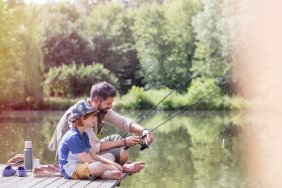Fly fishing seems to be in a league of its own. To outsiders, the artful casts and meticulously crafted lures associated with fly fishing may seem intimidating, but it really doesn’t need to be.
Anyone can give it a try, but there’s nothing wrong with learning a few tricks of the trade before heading out for your first fly fishing adventure. Here are six pointers that could make all the difference.
Polarized Glasses
Having spent many years confined to shore fishing, I can’t stress the importance of a good pair of polarized sunglasses. For fly anglers, they can make all the difference. They’ll help you read the water, observe how your fly is working, spot fish and detect strikes. Polarized glasses also reduce eye strain and help protect you from errant hooks, low hanging branches or bugs. To see through the water and get an edge when you’re fly fishing, pick up a pair of polarized glasses.
Don’t Forget to Fish
Many first-time fly fishermen become so focused/entranced with the technique of casting that they sometimes forget that there are fish in the water. I mean, you can only catch fish when your fly is out. Cast all you like and work on your technique to your heart’s content, but remember that casting is only a means to get the fly where you want it and is only half the battle.
Low Rod-er
You’ll want to keep your fly rod’s tip low when you’re fly fishing. With the rod tip at the water’s level, you can better keep in touch with the fly and more easily raise your rod to tug down on line when a fish strikes. If your rod is held high, your only option is tugging line and moving the rod tip behind you, which is awkward and really doesn’t do anything to help you.
Waders Aren’t Plan A
Waders are pretty much synonymous with fly fishing, but it’s important to remember that any time you wade, you run the risk of spooking fish, especially if it’s your first time out. Instead of immediately sloshing through the current, find a casting position on the shore if you can, so you don’t have to disturb the water. Be sure to step softly, keep a low profile and try not to throw a shadow across the water.
Don’t Limit Yourself to Trout
Over the years, fly fishing has branched out. Aside from trout, pike, bass, carp, panfish and muskie are exciting options on the fly. Many fly anglers even travel across the country to my neck of the woods, Michigan, to fight carp on their fly tackle. Even bluegill can put up a heck of a fight on a fly rod, so widen your options to include the available fish in your area.
Fly Fishing Isn’t Just for Rivers
It’s funny, but there are many fly anglers who think they’d look odd using a fly rod while lake fishing. For some reason, they’re convinced that the only proper way to fly fish is on a river. Lake fishing, though, provides a great alternative to the often crowded rivers and using a fly rod on a lake or farm pond poses new and exciting challenges, as well. Not only is there a potential to catch more species, but it also allows you to get in some practice and become familiar with your new fly gear.
Photo credit: Flickr CC








